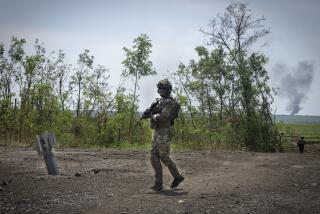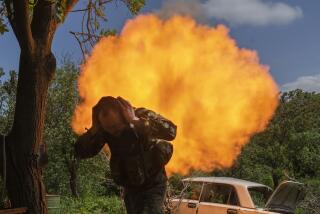Afghans Set Off to Root Out Al Qaeda, Taliban Holdouts
- Share via
SHAHI KOT VALLEY, Afghanistan — Hardened Afghan soldiers with tanks, rocket launchers and mortars advanced to the edge of this valley Monday, vowing to clean out nests of Al Qaeda and Taliban fighters who might still be lurking in its labyrinth of caves despite more than a week of bombing and firefights with U.S. troops.
No one knows how many enemy fighters might be in the valley after the U.S.-led onslaught, but the newly arriving Afghan forces clearly expected danger as they prepared to enter an area that many believe is the last stronghold of Al Qaeda and the Taliban in eastern Afghanistan.
In addition to Afghan warriors, U.S. and Australian special forces were still operating in the area. However, the bulk of regular U.S. troops were being flown back to Bagram air base about 125 miles north of the region, satisfied that the heaviest fighting was over.
The long column of Afghans, which lumbered out of the dusty provincial capital of Gardez about 7 a.m., consisted of 12 tanks, other military equipment and about 500 troops, said Abdul Matin, an Afghan brigade commander.
The soldiers are under the command of a former Northern Alliance general, Gul Hydar, who was sent to Gardez with 1,000 troops Friday by the Afghan Defense Ministry. They are to reinforce a U.S.-trained Afghan force led by Gen. Zia Lodin, which has been in the campaign since it was launched March 2.
The troops moved slowly over the bumpy, rutted, packed-earth road out of Gardez. Atop their tanks, bystanders said, soldiers smiled and waved their weapons.
Matin said the arrival of the troops from Kabul, the capital, was “very important” for Afghanistan’s interim government, led by Prime Minister Hamid Karzai, because it represented the first steps toward creating a national army.
“Anywhere in the country where there is trouble, forces should be sent out by the Defense Ministry to help,” Matin said.
By about 6 p.m., Hydar’s forces had taken up positions at an entrance to the valley, he said. Matin described the valley as very long, with four or five entrances. When entering the valley, the Afghan force will have to contend with whatever enemy hide-outs have not yet been detected and bombed, as well as with land mines and booby traps laid by the enemy.
Having visited the caves during his days as a moujahedeen fighter against Soviet occupiers in the 1980s, Matin said it was good that Afghans would do the close-in dirty work of seeking the last hiding places of Al Qaeda and the Taliban.
“The pathways to the caves are very hard to see for the Americans, and the caves themselves are labyrinthine,” he said.
Matin, who held a black Walther automatic in his lap, fiddled with a hand-held radio and talked to a reporter while riding in the back of a Toyota Land Cruiser, said he expected the final battle for Shahi Kot to begin within two or three days. Another soldier said he was told that the first fighting would take place before dawn today. As Monday night wore on, coalition aircraft could be heard crisscrossing the area.
Back at Bagram, a U.S. Special Forces senior officer, who identified himself only as Lt. Col. Mark, cautioned that the most risky part of the mission--scouring mountain ridges and caves for remaining Al Qaeda operatives--was still ahead.
“The more we back these kind of folks into a corner, the more desperate they are going to be,” he said. He added that between 100 and 200 enemy fighters were believed to be hunkered down “just trying to survive” in a system of caves high in the mountains overlooking the valley.
“I don’t know what the number is, but it’s not a big one,” he said.
Army Lt. Col. Chris Bentley, fire support coordinator for the operation, said Air Force and Marine aircraft had destroyed about 20 caves using ordnance including thermobaric bombs, which draw the oxygen out of a cave and leave it intact for further intelligence-gathering.
In Washington, Defense Secretary Donald H. Rumsfeld said U.S. and allied forces hope to finish “mopping up” Al Qaeda and Taliban fighters in the valley by the end of the week.
Rumsfeld said several prisoners had been taken and “a great many” enemy fighters killed in the offensive. Other officials have estimated the number killed at more than 700.
Additional U.S. troops returned to the Bagram air base Monday from the fighting zone. Four CH-47 Chinook helicopters disgorged what appeared to be more than 100 soldiers. Army officials declined to quantify by how much the U.S. force in the Shahi Kot area has been reduced and stressed that the battle, dubbed Operation Anaconda, continued.
Meanwhile, more details on the battle to date emerged, showing a mixture of mistaken estimates of enemy numbers and position, combined with a rapid response by U.S. troops forced into a defensive posture. And it became clear that an air attack, the dominant element of the U.S. war until Operation Anaconda’s ground warfare, helped reverse the fortune of ground troops.
Many returning troops said that, given the intensity and accuracy of the Al Qaeda and Taliban attacks and mortar fire, it was nearly miraculous that there weren’t more U.S. casualties--reported as eight killed and more than 80 wounded. Several companies reported being pinned down for hours, and one of them for nearly a day.
Originally intending to take up “blocking positions” to capture Al Qaeda and Taliban pockets flushed out by Lodin, U.S. troops quickly found themselves under fire and on the defensive. But that failure came after Lodin apparently encountered enemy forces far closer to him than where U.S. intelligence had pinpointed them and after he was bombarded with mortars.
“We have to remember what it is we asked Commander Zia to do on D-day,” said Mark, the Special Forces lieutenant colonel. “We asked him to be the lead element, to move into an area where we thought we had identified a pocket--the remaining significant pocket--of Al Qaeda and Taliban resistance. He found where the leading edge of his defense was, which was different than where we thought it would be.”
The lieutenant colonel said it was possible that enemy forces had advance warning of the attack, possibly from increased helicopter flights over the area in the weeks preceding the operation. He declined to blame the surprising level of resistance on an intelligence failure.
“He got knocked down,” Mark said of Lodin. “And then he got back up and he came back again into the same place where he lost about 10% of his people. And then he did it a third time. And he’s not done.”
The Special Forces officer’s spirited defense of Lodin came amid reports from the battlefield that, several times, the Afghan commander and his force of about 400 had failed to advance when expected.
It was only after air support arrived for both Lodin’s forces and pinned-down U.S. troops that the battle could be reversed, according to soldiers involved.
Israel Miller, 27, a psychological operations specialist from St. Louis, was among the first on the ground on the initial day of the operation. He said he was assigned to set up loudspeakers to warn civilians away from U.S. troops, as a way of determining who was hostile and who was a civilian fleeing villages in the valley.
Instead, 150 yards from the landing zone, enemy forces opened up on the U.S. troops with small arms and rocket-propelled grenades. The Americans were pinned down for an hour in the hilly terrain before helicopter gunships scattered or killed the attacking fighters, he said.
Charlie Company, consisting of about 45 men from the 1st Battalion of the 101st Airborne Division’s 187th Regiment, moved to another blocking position about three miles to the northwest, where they were subjected to a barrage of accurate mortar and machine-gun fire.
“They pretty much had us running around for a while, because we couldn’t get their position,” Miller said. “The closest [explosion] to me was just 20 meters [66 feet] away. . . . Shrapnel was flying overhead.”
For six hours, the men of Charlie Company were pinned down, with mortar shells landing at some points every few seconds. This time, a B-52 blew out the key mortar position about 1 1/2 miles away.
“After that, it was just sporadic,” Miller said. “The threat was pretty much over by then.”
Al Qaeda and Taliban forces apparently then launched a desperate assault on Charlie Company’s position with 200 fighters, Miller said. But aircraft spotted them, along with a column of nine vehicles mounted with machine guns approaching from another direction.
“We would’ve spotted them eventually, because we had all the high ground,” Miller said. But air coverage enabled them to hold their position.
“Luckily, the 200 people were neutralized from the air,” he said.
The intensity of the attacks, despite what quickly became U.S. troop superiority on high ground, surprised Miller.
“They weren’t holding back,” he said. “We gave them every chance to surrender. They had their minds set on killing Americans.”
*
Daniszewski reported from Zormat and Mohan from Bagram. Times staff writer Esther Schrader in Washington contributed to this report.
More to Read
Sign up for Essential California
The most important California stories and recommendations in your inbox every morning.
You may occasionally receive promotional content from the Los Angeles Times.













